mirror CHEVROLET UPLANDER 2007 1.G Owners Manual
[x] Cancel search | Manufacturer: CHEVROLET, Model Year: 2007, Model line: UPLANDER, Model: CHEVROLET UPLANDER 2007 1.GPages: 592, PDF Size: 3.04 MB
Page 1 of 592
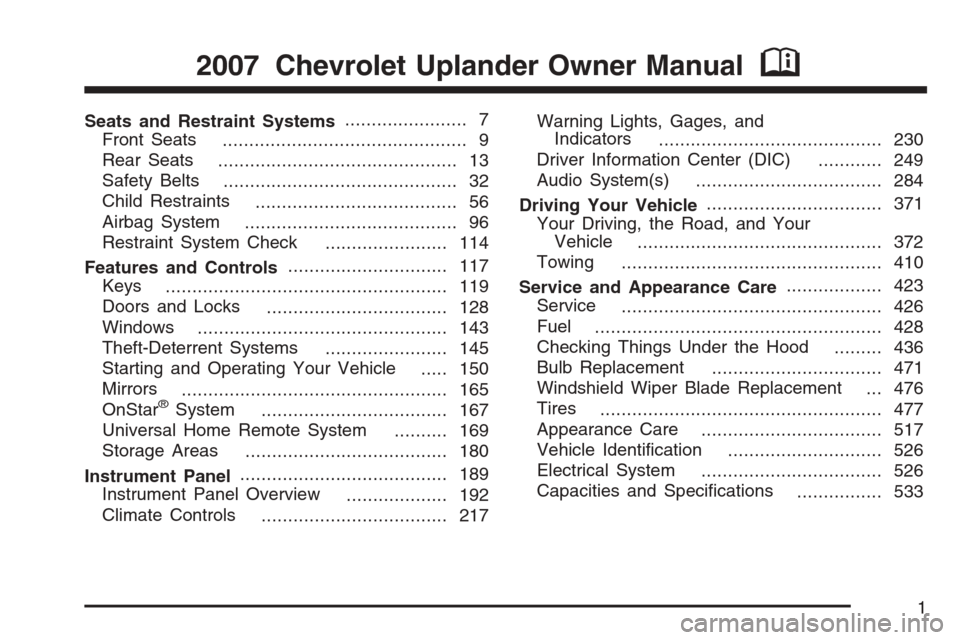
Seats and Restraint Systems....................... 7
Front Seats
.............................................. 9
Rear Seats
............................................. 13
Safety Belts
............................................ 32
Child Restraints
...................................... 56
Airbag System
........................................ 96
Restraint System Check
....................... 114
Features and Controls.............................. 117
Keys
..................................................... 119
Doors and Locks
.................................. 128
Windows
............................................... 143
Theft-Deterrent Systems
....................... 145
Starting and Operating Your Vehicle
..... 150
Mirrors
.................................................. 165
OnStar
®System
................................... 167
Universal Home Remote System
.......... 169
Storage Areas
...................................... 180
Instrument Panel....................................... 189
Instrument Panel Overview
................... 192
Climate Controls
................................... 217Warning Lights, Gages, and
Indicators
.......................................... 230
Driver Information Center (DIC)
............ 249
Audio System(s)
................................... 284
Driving Your Vehicle................................. 371
Your Driving, the Road, and Your
Vehicle
.............................................. 372
Towing
................................................. 410
Service and Appearance Care.................. 423
Service
................................................. 426
Fuel
...................................................... 428
Checking Things Under the Hood
......... 436
Bulb Replacement
................................ 471
Windshield Wiper Blade Replacement
... 476
Tires
..................................................... 477
Appearance Care
.................................. 517
Vehicle Identi�cation
............................. 526
Electrical System
.................................. 526
Capacities and Speci�cations
................ 533
2007 Chevrolet Uplander Owner ManualM
1
Page 118 of 592
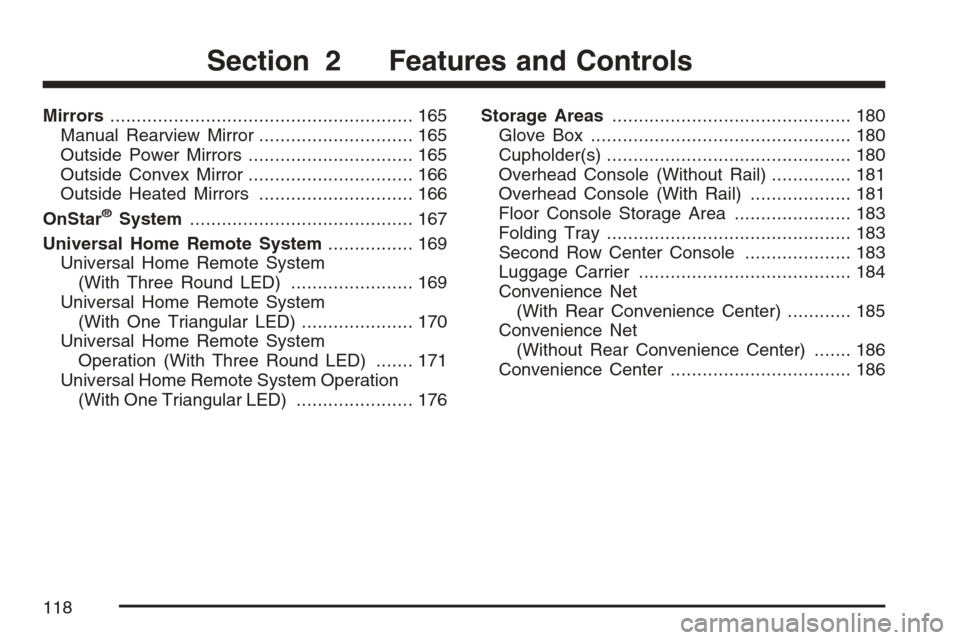
Mirrors......................................................... 165
Manual Rearview Mirror............................. 165
Outside Power Mirrors............................... 165
Outside Convex Mirror............................... 166
Outside Heated Mirrors............................. 166
OnStar
®System.......................................... 167
Universal Home Remote System................ 169
Universal Home Remote System
(With Three Round LED)....................... 169
Universal Home Remote System
(With One Triangular LED)..................... 170
Universal Home Remote System
Operation (With Three Round LED)....... 171
Universal Home Remote System Operation
(With One Triangular LED)...................... 176Storage Areas............................................. 180
Glove Box................................................. 180
Cupholder(s).............................................. 180
Overhead Console (Without Rail)............... 181
Overhead Console (With Rail)................... 181
Floor Console Storage Area...................... 183
Folding Tray.............................................. 183
Second Row Center Console.................... 183
Luggage Carrier........................................ 184
Convenience Net
(With Rear Convenience Center)............ 185
Convenience Net
(Without Rear Convenience Center)....... 186
Convenience Center.................................. 186
Section 2 Features and Controls
118
Page 145 of 592
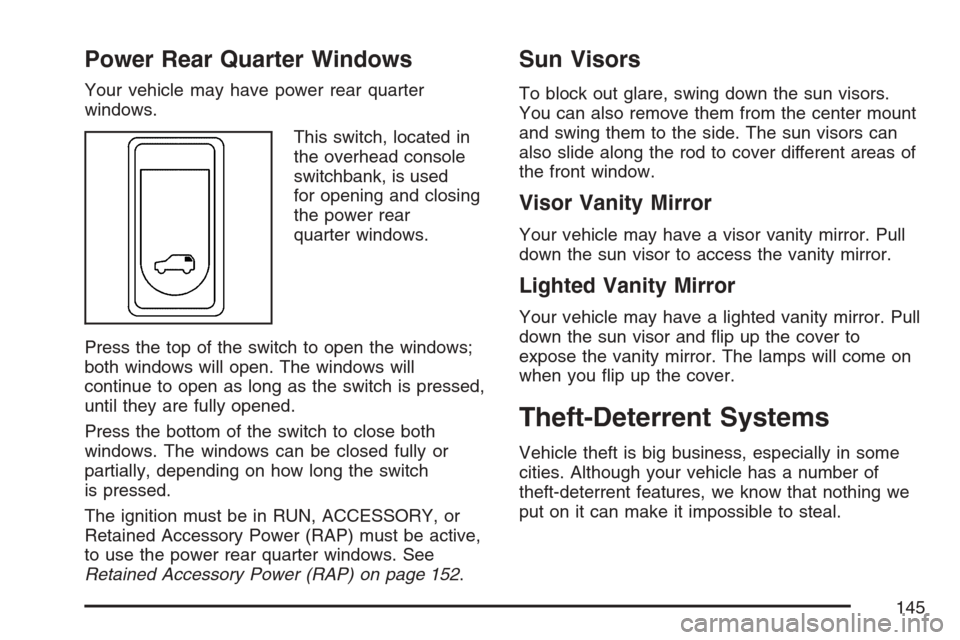
Power Rear Quarter Windows
Your vehicle may have power rear quarter
windows.
This switch, located in
the overhead console
switchbank, is used
for opening and closing
the power rear
quarter windows.
Press the top of the switch to open the windows;
both windows will open. The windows will
continue to open as long as the switch is pressed,
until they are fully opened.
Press the bottom of the switch to close both
windows. The windows can be closed fully or
partially, depending on how long the switch
is pressed.
The ignition must be in RUN, ACCESSORY, or
Retained Accessory Power (RAP) must be active,
to use the power rear quarter windows. See
Retained Accessory Power (RAP) on page 152.
Sun Visors
To block out glare, swing down the sun visors.
You can also remove them from the center mount
and swing them to the side. The sun visors can
also slide along the rod to cover different areas of
the front window.
Visor Vanity Mirror
Your vehicle may have a visor vanity mirror. Pull
down the sun visor to access the vanity mirror.
Lighted Vanity Mirror
Your vehicle may have a lighted vanity mirror. Pull
down the sun visor and �ip up the cover to
expose the vanity mirror. The lamps will come on
when you �ip up the cover.
Theft-Deterrent Systems
Vehicle theft is big business, especially in some
cities. Although your vehicle has a number of
theft-deterrent features, we know that nothing we
put on it can make it impossible to steal.
145
Page 165 of 592
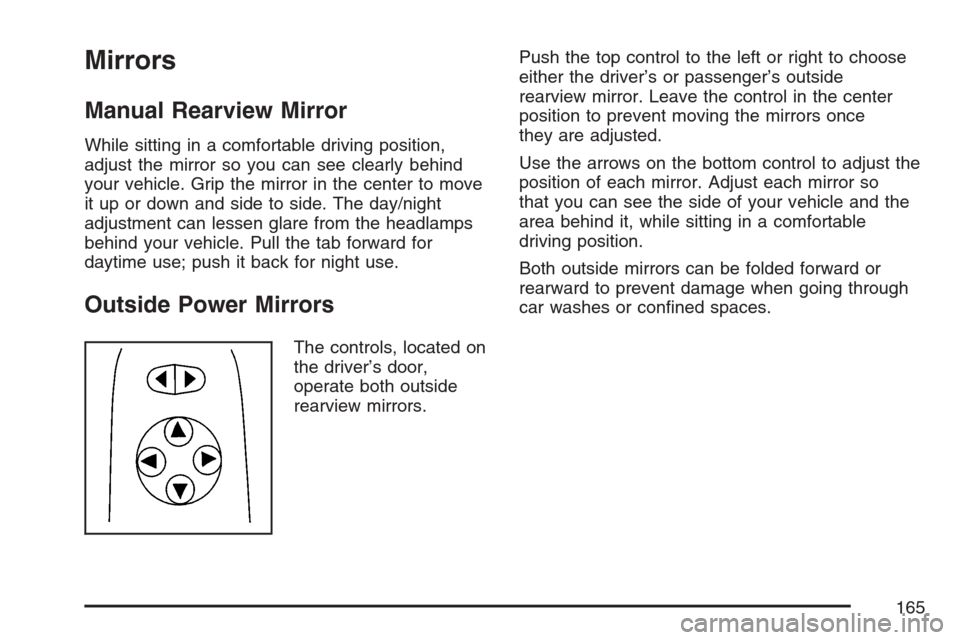
Mirrors
Manual Rearview Mirror
While sitting in a comfortable driving position,
adjust the mirror so you can see clearly behind
your vehicle. Grip the mirror in the center to move
it up or down and side to side. The day/night
adjustment can lessen glare from the headlamps
behind your vehicle. Pull the tab forward for
daytime use; push it back for night use.
Outside Power Mirrors
The controls, located on
the driver’s door,
operate both outside
rearview mirrors.Push the top control to the left or right to choose
either the driver’s or passenger’s outside
rearview mirror. Leave the control in the center
position to prevent moving the mirrors once
they are adjusted.
Use the arrows on the bottom control to adjust the
position of each mirror. Adjust each mirror so
that you can see the side of your vehicle and the
area behind it, while sitting in a comfortable
driving position.
Both outside mirrors can be folded forward or
rearward to prevent damage when going through
car washes or con�ned spaces.
165
Page 166 of 592
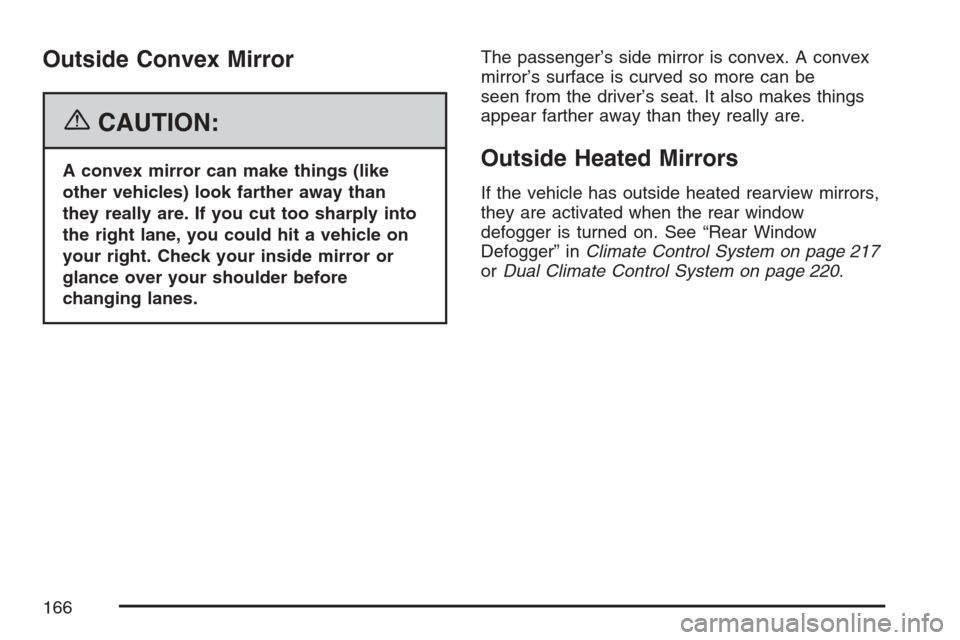
Outside Convex Mirror
{CAUTION:
A convex mirror can make things (like
other vehicles) look farther away than
they really are. If you cut too sharply into
the right lane, you could hit a vehicle on
your right. Check your inside mirror or
glance over your shoulder before
changing lanes.The passenger’s side mirror is convex. A convex
mirror’s surface is curved so more can be
seen from the driver’s seat. It also makes things
appear farther away than they really are.Outside Heated Mirrors
If the vehicle has outside heated rearview mirrors,
they are activated when the rear window
defogger is turned on. See “Rear Window
Defogger” inClimate Control System on page 217
orDual Climate Control System on page 220.
166
Page 386 of 592

So here are some tips for passing:
Drive ahead. Look down the road, to the
sides, and to crossroads for situations
that might affect your passing patterns. If you
have any doubt whatsoever about making
a successful pass, wait for a better time.
Watch for traffic signs, pavement markings,
and lines. If you can see a sign up ahead
that might indicate a turn or an intersection,
delay your pass. A broken center line
usually indicates it is all right to pass, providing
the road ahead is clear. Never cross a solid
line on your side of the lane or a double solid
line, even if the road seems empty of
approaching traffic.
Do not get too close to the vehicle you want
to pass while you are awaiting an opportunity.
For one thing, following too closely reduces
your area of vision, especially if you are
following a larger vehicle. Also, you will not
have adequate space if the vehicle ahead
suddenly slows or stops. Keep back a
reasonable distance.
When it looks like a chance to pass is
coming up, start to accelerate but stay in
the right lane and do not get too close.Time your move so you will be increasing
speed as the time comes to move into
the other lane. If the way is clear to pass, you
will have a running start that more than
makes up for the distance you would lose by
dropping back. And if something happens
to cause you to cancel your pass, you need
only slow down and drop back again and wait
for another opportunity.
If other vehicles are lined up to pass a slow
vehicle, wait your turn. But take care that
someone is not trying to pass you as you pull
out to pass the slow vehicle. Remember to
glance over your shoulder and check the
blind spot.
Check your vehicle’s mirrors, glance over your
shoulder, and start your left lane change
signal before moving out of the right lane to
pass. When you are far enough ahead of
the passed vehicle to see its front in
your vehicle’s inside mirror, activate the right
lane change signal and move back into
the right lane. Remember that your vehicle’s
passenger side outside mirror is convex.
The vehicle you just passed may seem to be
farther away from you than it really is.
386
Page 388 of 592
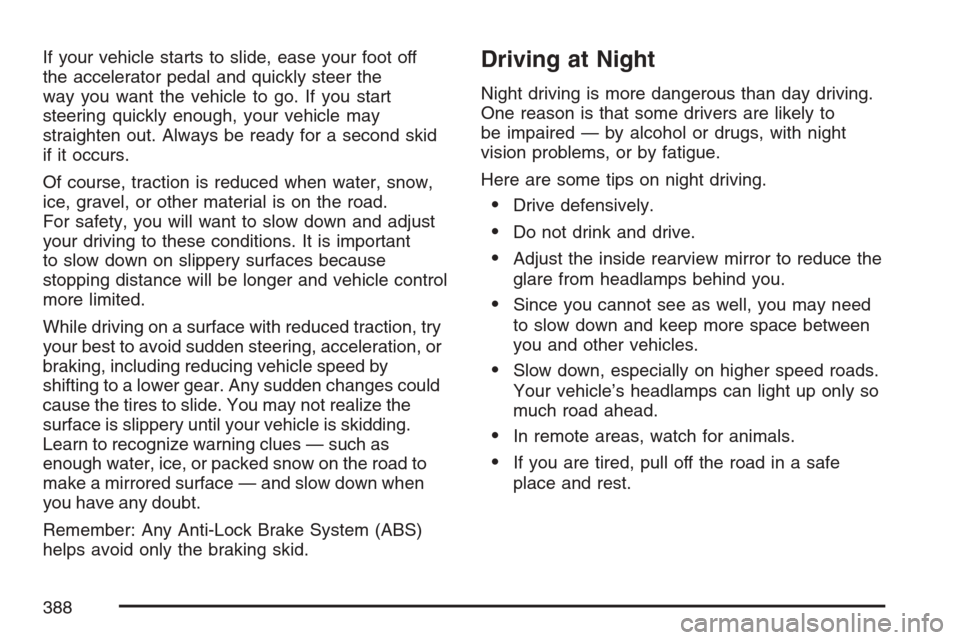
If your vehicle starts to slide, ease your foot off
the accelerator pedal and quickly steer the
way you want the vehicle to go. If you start
steering quickly enough, your vehicle may
straighten out. Always be ready for a second skid
if it occurs.
Of course, traction is reduced when water, snow,
ice, gravel, or other material is on the road.
For safety, you will want to slow down and adjust
your driving to these conditions. It is important
to slow down on slippery surfaces because
stopping distance will be longer and vehicle control
more limited.
While driving on a surface with reduced traction, try
your best to avoid sudden steering, acceleration, or
braking, including reducing vehicle speed by
shifting to a lower gear. Any sudden changes could
cause the tires to slide. You may not realize the
surface is slippery until your vehicle is skidding.
Learn to recognize warning clues — such as
enough water, ice, or packed snow on the road to
make a mirrored surface — and slow down when
you have any doubt.
Remember: Any Anti-Lock Brake System (ABS)
helps avoid only the braking skid.Driving at Night
Night driving is more dangerous than day driving.
One reason is that some drivers are likely to
be impaired — by alcohol or drugs, with night
vision problems, or by fatigue.
Here are some tips on night driving.
Drive defensively.
Do not drink and drive.
Adjust the inside rearview mirror to reduce the
glare from headlamps behind you.
Since you cannot see as well, you may need
to slow down and keep more space between
you and other vehicles.
Slow down, especially on higher speed roads.
Your vehicle’s headlamps can light up only so
much road ahead.
In remote areas, watch for animals.
If you are tired, pull off the road in a safe
place and rest.
388
Page 394 of 592

Freeway Driving
Mile for mile, freeways — also called thruways,
parkways, expressways, turnpikes, or
superhighways — are the safest of all roads. But
they have their own special rules.
The most important advice on freeway driving is:
Keep up with traffic and keep to the right.
Drive at the same speed most of the other driversare driving. Too-fast or too-slow driving breaks a
smooth traffic �ow. Treat the left lane on a freeway
as a passing lane.
At the entrance, there is usually a ramp that leads
to the freeway. If you have a clear view of the
freeway as you drive along the entrance ramp, you
should begin to check traffic. Try to determine
where you expect to blend with the �ow. Try to
merge into the gap at close to the prevailing speed.
Switch on your turn signal, check your mirrors, and
glance over your shoulder as often as necessary.
Try to blend smoothly with the traffic �ow.
Once you are on the freeway, adjust your speed
to the posted limit or to the prevailing rate if it
is slower. Stay in the right lane unless you want
to pass.
Before changing lanes, check your mirrors. Then
use your turn signal.
Just before you leave the lane, glance quickly
over your shoulder to make sure there is not
another vehicle in your blind spot.
Once you are moving on the freeway, make
certain you allow a reasonable following distance.
Expect to move slightly slower at night.
394
Page 396 of 592
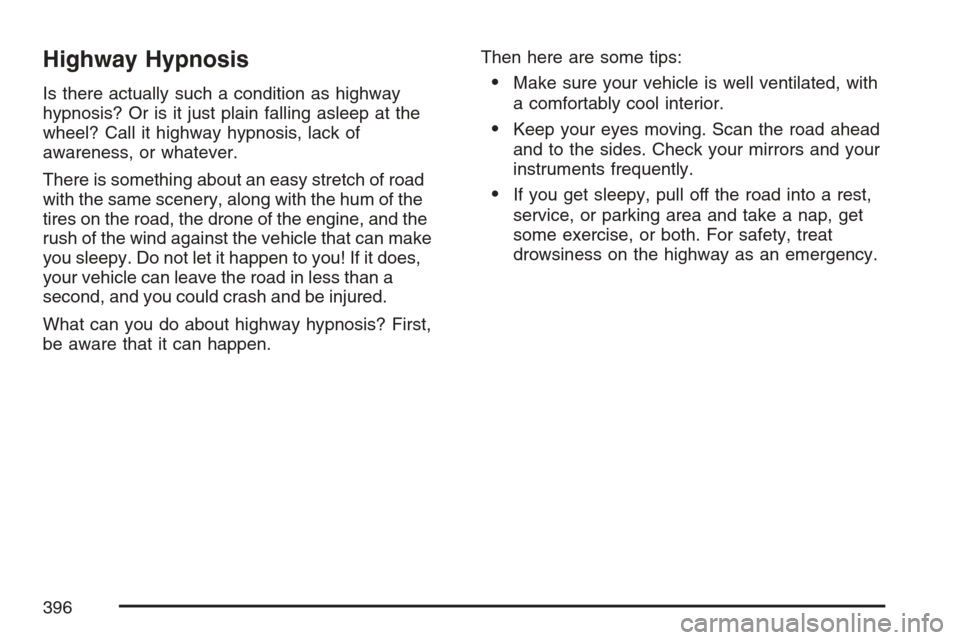
Highway Hypnosis
Is there actually such a condition as highway
hypnosis? Or is it just plain falling asleep at the
wheel? Call it highway hypnosis, lack of
awareness, or whatever.
There is something about an easy stretch of road
with the same scenery, along with the hum of the
tires on the road, the drone of the engine, and the
rush of the wind against the vehicle that can make
you sleepy. Do not let it happen to you! If it does,
your vehicle can leave the road in less than a
second, and you could crash and be injured.
What can you do about highway hypnosis? First,
be aware that it can happen.Then here are some tips:Make sure your vehicle is well ventilated, with
a comfortably cool interior.
Keep your eyes moving. Scan the road ahead
and to the sides. Check your mirrors and your
instruments frequently.
If you get sleepy, pull off the road into a rest,
service, or parking area and take a nap, get
some exercise, or both. For safety, treat
drowsiness on the highway as an emergency.
396
Page 420 of 592
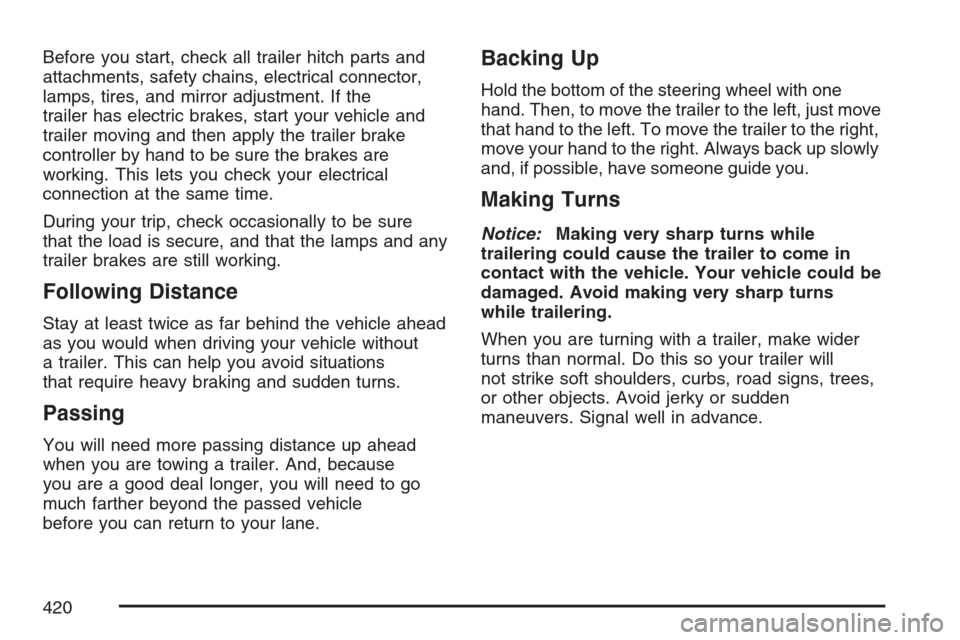
Before you start, check all trailer hitch parts and
attachments, safety chains, electrical connector,
lamps, tires, and mirror adjustment. If the
trailer has electric brakes, start your vehicle and
trailer moving and then apply the trailer brake
controller by hand to be sure the brakes are
working. This lets you check your electrical
connection at the same time.
During your trip, check occasionally to be sure
that the load is secure, and that the lamps and any
trailer brakes are still working.
Following Distance
Stay at least twice as far behind the vehicle ahead
as you would when driving your vehicle without
a trailer. This can help you avoid situations
that require heavy braking and sudden turns.
Passing
You will need more passing distance up ahead
when you are towing a trailer. And, because
you are a good deal longer, you will need to go
much farther beyond the passed vehicle
before you can return to your lane.
Backing Up
Hold the bottom of the steering wheel with one
hand. Then, to move the trailer to the left, just move
that hand to the left. To move the trailer to the right,
move your hand to the right. Always back up slowly
and, if possible, have someone guide you.
Making Turns
Notice:Making very sharp turns while
trailering could cause the trailer to come in
contact with the vehicle. Your vehicle could be
damaged. Avoid making very sharp turns
while trailering.
When you are turning with a trailer, make wider
turns than normal. Do this so your trailer will
not strike soft shoulders, curbs, road signs, trees,
or other objects. Avoid jerky or sudden
maneuvers. Signal well in advance.
420